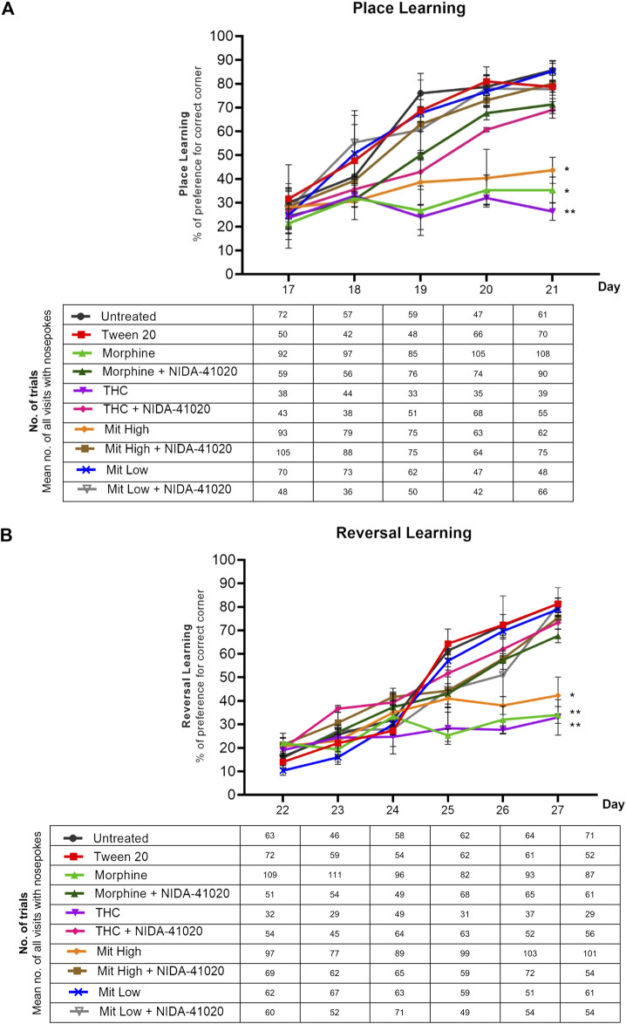A comprehensive and detailed study in mice from University of Science, Malaysia revealed mitragynine in very high doses is an agonist (binds to and activates) cannabinoid receptor Type 1 (CB1). Mice administered with high-dose mitragynine demonstrated similar reward-seeking behavior and cognitive impairment as mice administered with morphine and THC. Mice that received high-dose mitragynine, morphine, and THC with a CB1 antagonist (a compound that binds to a deactivates the CB1 receptor), did not exhibit similar cognitive impairment, nor did mice that received low-dose mitragynine (Iman et al., 2021).
Every animal has an endocannabinoid system (ECS). Discovered in the 1990s, this system is still relatively new to science. Peter Grinspoon calls the ECS a”vast network of chemical signals and cellular receptors that are densely packed throughout our brains and bodies” that “regulates and controls many of our most critical bodily functions”. The CB1 receptor, Dr. Grinspoon writes, “act like traffic cops to control the levels and activity of most of the other neurotransmitters” (2021).
Just like the body produces endogenous opioids, it also produces endogenous cannabinoids (endocannabinoids). The pleasurable effects of these compounds are part of the reason why the use of opium and cannabis by human beings can be traced back to ancient history.
Mitragynine, the main and most studied alkaloid in kratom, is a dynamic alkaloid. Much attention has been paid to the fact that mitragynine binds to opioid receptors, but it also binds to adrenergic, seratonin, and, as shown in this study, cannabinoid receptors. It also interacts with some of the other 40+ alkaloids in kratom in a way that makes the effects of mitragynine alone different from the effects natural kratom with its full spectrum of alkaloids.
One hundred mice in the Iman study were divided into ten groups. One group was left alone, and nine groups given injections into the abdomen of: a vehicle solution, low-dose mitragynine, high-dose mitragynine, morphine, THC, and four groups given those four categories of drug compounds along with NIDA-41020, a CB1 receptor antagonist.
The groups given morphine, THC, and high-dose mitragynine all exhibited higher levels of reward-seeking behavior and impairment of place learning and reversal learning. None of the other groups exhibited these behaviors, including the morphine, THC, and high-dose mitragynine groups that received the CB1 antagonist. This suggests that CB1 receptor agonism by the morphine, THC, and high-dose mitragynine is where the impairment in cognitive functioning comes from.
Reward-seeking behavior was measured by increased affinity for sucrose over water, and increased affinity for sucrose despite “punishment”, which, in this case, was an air puff blown at the mice as they went for the sucrose. Reward-seeking behavior is usually seen as an indicator of dependence or addiction.
Place learning in this study trained mice to find water in a certain corner of their cages, and to open the door to the water with three nose pokes. In reversal learning, the water was then placed in the opposite corner. All groups exhibited relatively similar ability to find water except for the groups treated with morphine, THC, and high-dose mitragynine without the CB1 receptor antagonist. These groups were markedly slower to learn.
What does this mean to humans? High-dose mitragynine in this case is up to 25 mg/kg. The human equivalent of such a dose is about 1/6 gram for a 175 pound adult, which doesn’t seem to be out of the realm of possibility in a strong dose of a full spectrum extract. But responsible kratom consumers, who constitute a majority, typically don’t consume high doses of strong extracts, and thus do not experience any cognitive impairment that’s more common in the use of cannabis and morphine. A majority of powdered or fresh leaf kratom consumers would fall into the “low dose mitragynine” category.
In fact, another study from University of Science Malaysia, led by past Kratom Science Podcast guest, Dr. Darshan Singh, found no significant cognitive impairment in long term kratom users. Consumers of kratom where it grows natively tend not to use high doses of kratom. Traditional methods of administration such as brewing tea and the chewing of leaves serves to prevent ingestion of a high level of alkaloids.
Dosage is not the only factor determining effects of pure mitragynine. The heath of the consumer is also a major factor. A study just published yesterday (October 25, 2021) in the journal Psychopharmacology, authored by two of the same researchers as the study examined above, found mitragynine increased the cognitive performance of mice. Only this time, the mice were withdrawing from morphine. Mitragynine given over a period of three days to mice in morphine-withdrawal “was able to alleviate the withdrawal signs” while it “did not affect the recognition memory in the NOR [novel object recognition test] but significantly improved the reversal learning deficit in the morphine-withdrawn rats.” (You et al., 2021).
Listen to Dr. Jonathan Cachat and host Brian Gallagher discuss the Iman study on the next episode of Kratom Science Journal Club, this Thursday, October 28 available here or on your favorite podcast platform.
References
- Grinspoon, P. (2021, August 11). The endocannabinoid system: Essential and mysterious. Harvard Health Publishing. https://www.health.harvard.edu/blog/the-endocannabinoid-system-essential-and-mysterious-202108112569
- Iman, I. N., Ahmad, N., Mohd Yusof, N. A., Talib, U. N., Norazit, A., Kumar, J., Mehat, M. Z., Hassan, Z., Müller, C. P., & Muzaimi, M. (2021). Mitragynine (Kratom)-Induced Cognitive Impairments in Mice Resemble Δ9-THC and Morphine Effects: Reversal by Cannabinoid CB1 Receptor Antagonism. Frontiers in pharmacology, 12, 708055. https://doi.org/10.3389/fphar.2021.708055
- You CY, Hassan Z, Müller CP, Suhaimi FW. Mitragynine improves cognitive performance in morphine-withdrawn rats. Psychopharmacology (Berl). 2021 Oct 25. doi: 10.1007/s00213-021-05996-4. Epub ahead of print. PMID: 34693456.

